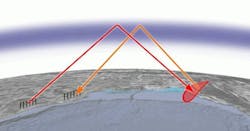DARPA to brief industry this week on HF radio waves ionospheric test instruments for over-the-horizon radar
ARLINGTON, Va. – U.S. military researchers will brief industry this week on an upcoming project to create test instruments suitable for high-frequency (HF) surface-wave and sky-wave over-the-horizon radar (OTHR).
Officials of the U.S. Defense Advanced Research Projects Agency (DARPA) in Arlington, Va., will brief industry by virtual proposers day from 1 to 4 p.m. on Friday 8 March via Zoom on the Transponders for Ionospheric Measurement (TIM) program.
TIM seeks to create distributable channel sounding and test instrumentation that will measure and respond to HF radio waves.
The goal is to capitalize on commercial communications devices to create test instruments suitable for HF surface-wave and sky-wave over-the-horizon radar (OTHR) using small, lightweight, and power-efficient transponders.
Instrumentation nodes will have three functions: receive, modulate, and retransmit radar signals; measure the propagation channel response using a chirp-sounding receive function; and capture and relay portions of the HF radio band for analysis.
The vision for TIM is to coordinate several test instrumentation nodes to help improve understanding of HF radio propagation across a wide geographic area and to perform as test signal sources for improving HF radar performance.
A centralized control capability, developed separately, will integrate the measurements from distributed sensors to assimilate a consistent ionospheric model and generate test scenarios by coordinating the transponder delay and Doppler responses.
The captured narrow-band segments will provide information on the stability of the propagation channel between the radar and the receiver. Small-size instrumentation will help procure significant quantities necessary for cost-effective wide-area deployments.
Companies interested should act quickly by registering for the virtual industry day by 5 p.m. eastern time today, 5 March 2024, online at https://web.cvent.com/event/50008ee2-db13-47f4-b9d0-37a1f88a550f/summary.
Email questions or concerns to DARPA's Frank Robey at [email protected]. More information is online at https://sam.gov/opp/5aac901d6a3746ecab6914e5e2a12331/view.
